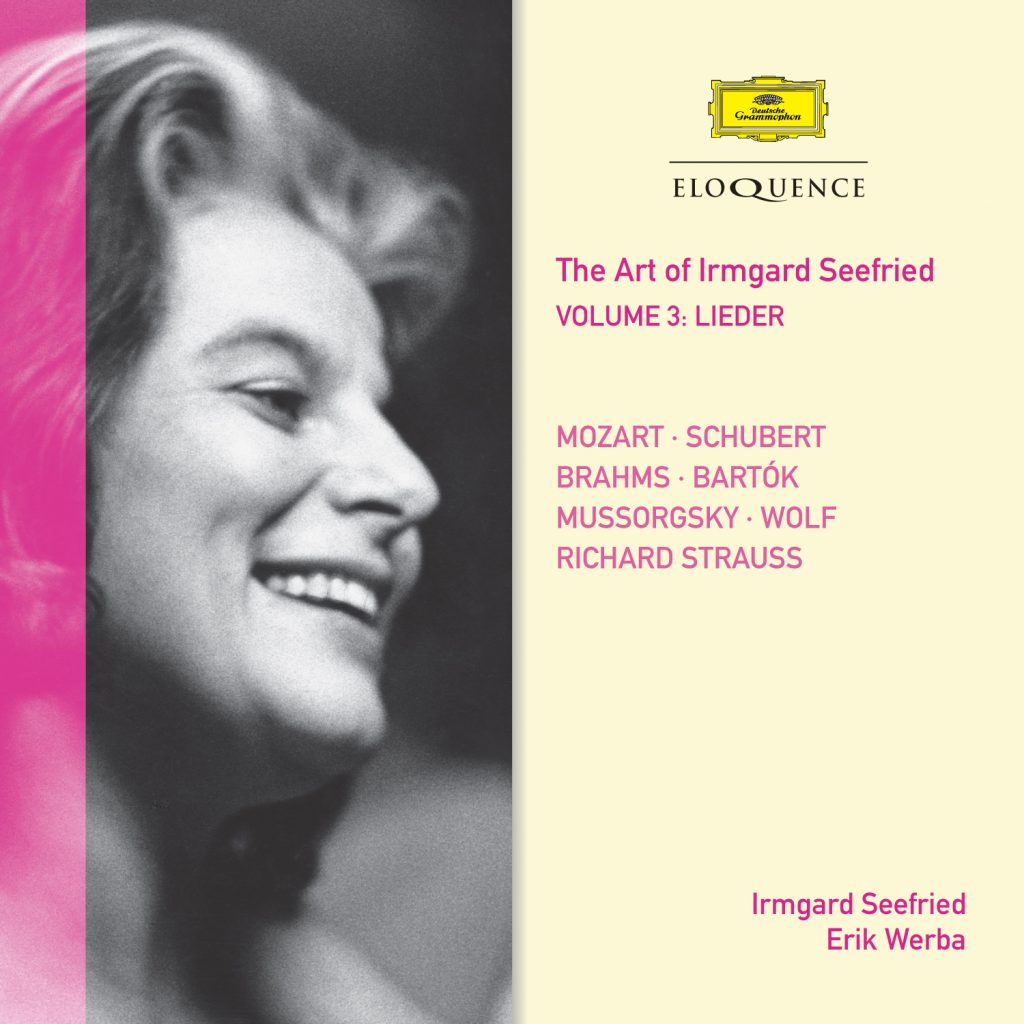‘If I were condemned to hear only one voice for the remainder of my life I think it might well be hers. If I wanted to be charmed, to laugh or cry I would find her the perfect companion. In her singing … we hear someone whose every utterance bespeaks natural sincerity and truthful feeling’
ALAN BLYTH on IRMGARD SEEFRIED (Gramophone)
After Irmgard Seefried’s death in 1988, her contemporary Elisabeth Schwarzkopf – never one to dish out compliments lightly – commented: ‘All of us envied her, because what we had to achieve laboriously worked for her so naturally and as a matter of course, because she knew how to sing from the heart’.
Freshness, spontaneity, natural warmth of feeling, allied to a voice of gleaming beauty and a delightful stage presence: these were the hallmarks of a much-loved soprano who for three decades charmed and moved audiences in the theatre and concert hall, her face as expressive as her voice. As John Steane memorably put it in Gramophone, ‘it was as though she wore her own spotlight’.
Born in the Swabian town of Köngetried in 1919, Seefried was ‘discovered’, aged twenty, by Herbert von Karajan in Aachen, where she made her operatic debut as the Priestess in ‘Aida’. In 1943, she sang Eva in ‘Die Meistersinger’ for the Wiener Staatsoper, initiating an association that lasted until 1976. It was in Strauss and Mozart that Seefried was most admired.
Issued over eleven single-disc volumes, Deutsche Grammophon/ Eloquence pays tribute to Irmgard Seefried, bringing back to circulation several recordings that have never previously been issued on CD. The music ranges through opera and oratorio, with an especially generous offering of art song from a range of composers, including Schubert, Schumann, Wolf, Hindemith and Egk. The notes for the series have been written by that leading connoisseur of the voice, Richard Wigmore.
Seefried’s radiance and imaginative strength also made her a cherishable Lieder singer over an enterprisingly broad repertoire. Like her colleague Elisabeth Schwarzkopf, she championed the songs of Mozart at a time when only the merest handful were regularly heard in recital. Her 1957 recording of ten songs with her pianist of choice, Erik Werba, was widely hailed for its natural grace and simple sincerity of feeling. Recorded ‘live’ in Munich, Bielefeld, Berlin and Hamburg, this LP forms a fitting pair to the 1957 Mozart recordings.
WOLFGANG AMADEUS MOZART
Das Veilchen, KV 476
Die Verschweigung, KV 518
Das Lied der Trennung, KV 519
Das Kinderspiel, KV 598
Die kleine Spinnerin, KV 531
Als Luise die Briefe ihres ungetreuen Liebhabers verbrannte, KV 520
Einsam ging ich jüngst im Haine, KV 308 (KV 295b)
An Chloe, KV 524
Abendempfindung, KV 523
Sehnsucht nach dem Frühling, KV 596
FRANZ SCHUBERT
Auf dem Wasser zu singen, D.774
Lachen und Weinen, D.777
JOHANNES BRAHMS
Dein blaues Auge hält so still, Op. 59 No. 8
Ständchen, Op. 106 No. 1
MODEST PETROVICH MUSSORGSKY
Kinderstube (The Nursery)
BÉLA BARTÓK
Dorfszenen, Sz.78 (Village Scenes)
HUGO WOLF
3 Mörike-Lieder
RICHARD STRAUSS
Ständchen, Op. 17 No. 2
Irmgard Seefried, soprano
Erik Werba, piano
Recording Producers: Hans Ritter (1–10); Karl-Heinz Schneider (11–29)
Balance Engineers: Heinz Wildhagen (1–10); Gerhard Henjes (11–29)
Recording Locations: Brahmssaal, Vienna, Austria, 7–9 October 1957 (1), 6 October 1957 (2–10); Live recordings made during German concert tour, 1953: Munich (11, 18–20, 29), Bielefeld (12), Berlin (13–14, 21–28), Hamburg (15–17)
‘If I were condemned to hear only one voice for the remainder of my life I think it might well be hers. If I wanted to be charmed, to laugh or cry I would find her the perfect companion. In her singing on [this disc] we hear someone whose every utterance bespeaks natural sincerity and truthful feeling … ‘Das Lied der Trennung’ is a template of all she had to offer in this repertory: creamy tone, easy, unruffled legato, the unforced treatment of the text … ‘Abendemfinding’ … has all the depth of emotion … ‘Auf dem Wasser zu singen’, from a live 1953 recital, has the soul floating over the water with easeful poise. … Brahms’ ‘Ständchen’ has the sense of pure joy that cannot be learnt; it is part of a singer’s makeup or it is not. Seefried had it in abundance.’ Gramophone

